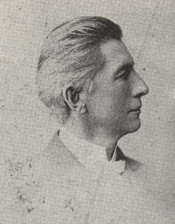
Charles Gerard Conn's Congressional portrait, 1893.
Charles Gerard Conn (29 January 1844 – 5 January 1931) was an entrepreneur, band instrument manufacturer, and U.S. Representative from Indiana.
Biography[]
Charles Gerard Conn was born in Phelps, New York on January 29, 1844. In 1850, he accompanied his family to Three Rivers, Michigan and in the following year to Elkhart, Indiana. Little is known about his early life, other than that he learned to play the cornet. With the outbreak of the American Civil War he enlisted in the United States Army on May 18, 1861 at the age of seventeen, despite his parents' protests. On June 14, 1861 he became a private in Company B, 15th Regiment Indiana Infantry, and shortly afterwards was assigned to a regimental band. When his enlistment expired he returned to Elkhart, but re-enlisted on December 12, 1863 at Niles, Michigan in Company G, 1st Michigan Sharpshooters. At the age of nineteen on August 8, 1863 he was elevated to the rank of Captain. During the Assault on Petersburg on July 30, 1864, Conn was wounded and taken prisoner. In spite of two imaginative and valiant attempts to escape, he was recaptured and spent the remainder of the war in captivity. At the end of hostilities, he was released from Columbia, South Carolina prison camp, and was honorably discharged on July 28, 1865.
After the war he engaged in the grocery and bakery business. In 1871, while serving as a band leader in Buchanan, Michigan, Conn badly injured his hand while working at the local zinc Horse collar-pad factory.[1] The accident forced Conn to switch from violin to cornet.
In 1877, Conn and his wife, Catherine, relocated to Elkhart, Indiana, where Conn worked various jobs for two years. During this time, Conn sold health care products under the tradename "Konn's Kurative Kream",[1] and invented parts for sewing machines. He also plated and engraved silverware, and manufactured rubber stamps.[1] Drawing from the skills learned at his previous jobs, he invented a cornet mouthpiece with a rubber rim, which began his career in the manufacture of band instruments[1] Conn was an important innovator in the development of modern wind instruments, and established the C.G. Conn Company, a major instrument manufacturer, in Elkhart.
Charles Conn was elected Mayor of Elkhart in 1880.[2] In 1884 Conn organized the 1st Regiment of Artillery in the Indiana Legion and became its first Colonel, a military title which stayed with him throughout the remainder of his life. He was also the first commander of the Elkhart Commandery of the Knights Templar. Colonel Conn also served as Lieutenant Colonel of the 2nd Regiment of Uniform Rank, Knights of Pythias, and was re-elected many times as Commander of the local G.A.R. post.
Conn served as mayor of Elkhart from 1880 until 1883, and as member of the Indiana state House of Representatives in 1889. He established the "Elkhart Daily Truth" in 1889.[3]
Conn was elected as a Democrat to the Fifty-third Congress (4 March 1893 - 3 March 1895), but he was not a candidate for renomination in 1894. Conn bought the newly established "Washington Times" in 1894, during his congressional term of which Stilson Hutchins (1838-1912) was later to serve as publisher (who himself previously founded and owned "The Washington Post", 1877-1889, (later one of the nation's most influential newspapers by the mid-20th Century) prior to selling "The Times" to the newspaper syndicate of Frank A. Munsey (1854-1925) who later sold it in 1917 to William Randolph Hearst (1863-1951). Later purchased by Eleanor Josephine Medill Patterson "Cissy" Patterson (1881-1941) (of the Medill-McCormick-Patterson families which owned the conservative Chicago Tribune and later founded the trend-setting New York Daily News and Newsday on New York's Long Island) who later merged it with The Washington Herald" and became the "Washington Times-Herald" to 1954 when it was absorbed by "The Post" now under the Meyer-Graham family (with the name of "Times-Herald" remaining on the masthead until 1973).[4]
After his term in Congress, Conn resumed the manufacture of band instruments at Elkhart, Indiana. In 1916 he retired and moved to Los Angeles, California. Conn authored books in his retirement, including The Sixth Sense, Prayer: Brain Cell Reformation (1916), For the Good of the World. Finding the Real God (1919), The Wonder Book: How to Achieve Success (1923). Charles Gerard Conn died 5 January 1931 in Los Angeles, and was interred in Grace Lawn Cemetery, Elkhart, Indiana.[5]
References[]
- ↑ 1.0 1.1 1.2 1.3 Banks, Margaret Downie (Ph.D.), Senior Curator of Musical Instruments, National Music Museum. "A Brief History of the Conn Company (1874-present)". Vermillion, South Dakota. http://people.usd.edu/~mbanks/CONN1.html#form. Retrieved 22 February 2012.
- ↑ Ksander, Yaël (15 September 2008). "Conn Instruments". http://indianapublicmedia.org/momentofindianahistory/conn-instruments/. Retrieved 22 February 2012.
- ↑ Banks, Margaret Downie (Ph.D.), Senior Curator of Musical Instruments, National Music Museum. "Col. Conn's Journalistic and Political Pursuits (1889-1897)". Vermillion, South Dakota. http://people.usd.edu/~mbanks/CONN5.html#DC. Retrieved 22 February 2012.
- ↑ "About The Washington times. (Washington [D.C.) 1902-1939"]. National Endowment for the Humanities. http://chroniclingamerica.loc.gov/lccn/sn84026749/. Retrieved 22 February 2012.
- ↑ "Conn, Charles Gerard, (1844 - 1931)". Biographical Directory of the United States Congress. http://bioguide.congress.gov/scripts/biodisplay.pl?index=C000683. Retrieved 22 February 2012.
- Charles G. Conn at the Biographical Directory of the United States Congress Retrieved on 2009-03-31
- "Charles G. Conn". Find a Grave. http://www.findagrave.com/memorial/7779006. Retrieved 2009-03-31.
This article incorporates public domain material from the Biographical Directory of the United States Congress website http://bioguide.congress.gov.
The original article can be found at Charles G. Conn and the edit history here.